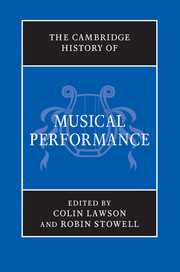Book contents
- Frontmatter
- PART I PERFORMANCE THROUGH HISTORY
- PART II PRE-RENAISSANCE PERFORMANCE
- 7 The Ancient World
- 8 Performance before c. 1430: an overview
- 9 Vocal performance before c. 1430
- 10 Instrumental performance before c. 1430
- 11 Case study: Guillaume de Machaut, ballade 34, ‘Quant Theseus / Ne quier veoir’
- PART III PERFORMANCE IN THE RENAISSANCE (C. 1430–1600)
- PART IV PERFORMANCE IN THE SEVENTEENTH CENTURY
- PART V PERFORMANCE IN THE ‘LONG EIGHTEENTH CENTURY’
- PART VI PERFORMANCE IN THE NINETEENTH CENTURY
- PART VII THE TWENTIETH CENTURY AND BEYOND
- PART VIII
- Index
10 - Instrumental performance before c. 1430
from PART II - PRE-RENAISSANCE PERFORMANCE
Published online by Cambridge University Press: 28 March 2012
- Frontmatter
- PART I PERFORMANCE THROUGH HISTORY
- PART II PRE-RENAISSANCE PERFORMANCE
- 7 The Ancient World
- 8 Performance before c. 1430: an overview
- 9 Vocal performance before c. 1430
- 10 Instrumental performance before c. 1430
- 11 Case study: Guillaume de Machaut, ballade 34, ‘Quant Theseus / Ne quier veoir’
- PART III PERFORMANCE IN THE RENAISSANCE (C. 1430–1600)
- PART IV PERFORMANCE IN THE SEVENTEENTH CENTURY
- PART V PERFORMANCE IN THE ‘LONG EIGHTEENTH CENTURY’
- PART VI PERFORMANCE IN THE NINETEENTH CENTURY
- PART VII THE TWENTIETH CENTURY AND BEYOND
- PART VIII
- Index
Summary
Introduction
From the outset it is important to restate the inevitable disclaimer: our knowledge of medieval instruments and medieval instrumental performance practice is severely limited by the nature of the historical evidence at our disposal. Virtually no stringed instrument survives from before 1500, and even if several specimens had survived they could only represent a fraction of the vast array of instrument types that were produced in medieval Europe. Secondly, the problem of correctly matching the medieval representations and descriptions of musical instruments in visual and literary sources with their contemporaneous designations can be quite thorny in itself – witness the case of the gittern/citole/mandora/cittern discussed below – since those representations are very often frustratingly ambiguous on key details of manufacturing and performance practice (one case for all: the problem of bridge shapes in bowed instruments before c.1470). Given this scenario, the study of the history of medieval instruments relies more on arguments based on inference, common sense and musical judgement, than on the evidence of the primary sources.
If the goal of accurately reconstructing the musical instruments used centuries ago faces insurmountable difficulties, the related task of pinpointing the specific contexts, circumstances and conventions of instrumental performance poses even thornier problems. The issue is not just that the world of medieval instrumental music belonged to a cultural domain – orality – that by definition left very few written traces. What complicates the historian’s task is also the localised nature of the documentary evidence, which in no way can do justice to the myriad of performing traditions and conventions that for centuries developed and interacted on the European scene and in counterpoint with non-European musical cultures (most prominently, Islam).
- Type
- Chapter
- Information
- The Cambridge History of Musical Performance , pp. 261 - 278Publisher: Cambridge University PressPrint publication year: 2012

